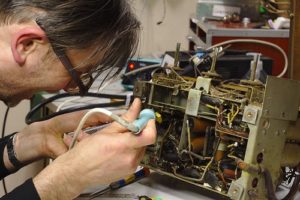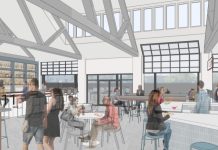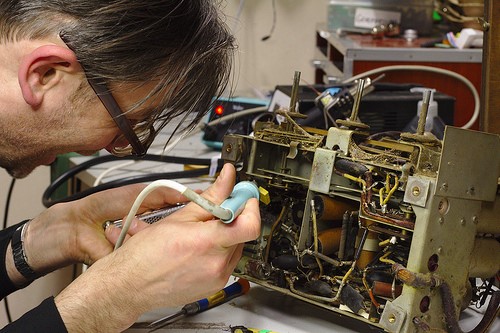Submitted by Phil Cornell for Olympia Amateur Radio Society
It is a technical hobby that is a constant learning experience.
It is a social experience, “Facebook” without the computer.
It is public service.
It is open to everyone and doesn’t cost a fortune to participate.
It’s great fun and hard work with good friends.
It is building a complex set of electronic components.
It is the challenge, the pride of using a station one has built to make challenging contacts with other hams around the world.
It is talking to people around the world, helping us understand different cultures and customs.
It is global, person-to-person diplomacy at its best.
It is not CB radio.
An amateur radio operator is tested and licensed and has proven the he/she knows some basic electronics theory, and knows and complies with federal regulations set down by the FCC.
Why is it called “Ham Radio”?

Have you ever wondered why radio amateurs are called “hams”? Well, it goes like this: The word “ham” as applied to 1908 was the station call of the first amateur wireless stations operated by some amateurs of the Harvard Radio Club. They were Albert S. Hyman, Bob Almy and Poogie Murray.
At first, they called their station “Hyman-Almy-Murray”. Tapping out such a long name in code soon became tiresome and called for a revision. They changed it to “HY-AL-MU,” using the first two letters of each of their names. Early in 1901 some confusion resulted between signals from amateur wireless station “HYALMU” and a Mexican ship named “HYALMO.” They then decided to use only the first letter of each name, and the station call became “Ham.”
In the early pioneer days of unregulated radio amateur operators picked their own frequency and call-letters. Then, as now, some amateurs had better signals than commercial stations. The resulting interference came to the attention of congressional committees in Washington and Congress gave much time to proposed legislation designed to critically limit amateur radio activity. In 1911 Albert Hyman chose the controversial wireless regulation bill as the topic for his Thesis at Harvard. His instructor insisted that a copy be sent to Senator David I. Walsh, a member of one of the committees hearing the Bill. The Senator was so impressed with the thesis is that he asked Hyman to appear before the committee. Albert Hyman took the stand and described how the little station was built and almost cried when he told the crowded committee room that if the bill went through that they would have to close down the station because they could not afford the license fees and all the other requirements which the bill imposed on amateur stations.
Congressional debate began on the Wireless Regulation Bill and little station “Ham” became the symbol for all the little amateur stations in the country crying to be saved from the menace and greed of the big commercial stations who didn’t want them around. The bill finally got to the floor of Congress and every speaker talked about the “…poor little station Ham.” That’s how it all started. You will find the whole story in the Congressional Record.
Nation-wide publicity associated station “”Ham” with amateur radio operators. From that day to this, and probably until the end of time in radio an amateur is a “Ham.”
How much does it cost?
Not too much, really, about the price of dinner and a movie. The license study guides and practice questions are available for free on the internet. The license test is $15. A very good starter radio for new Technician Class operators, the Baofeng UV-5R, runs about $35. So, $50 and you are a Ham, and you’re on the air too!
Becoming a ham costs $15, building your station can cost from $35 to thousands, the Icom IC-7851,a top of the line, multi-band radio, runs $16,000. Nice rig, lots of knobs, bells and whistles, but well out of my budget. Good, used, HF radios can be found for $500-$1000, check eBay or Ham Radio Outlet or the many other ham radio retailers. It depends on the depth of your pockets and how intensively you want to participate in this hobby. Personally, I have spent close to $5000.00, over 40 years, building my station. I have several HT’s (Handheld Transceiver), three VHF radios, two HF/VHF/UHF radios, several VHF antennas, two HF antennas, modems and interfaces for digital communications, and a bunch of test equipment. This may sound impressive, but it is an average station and these items were purchased, some new – some used, over many years. I have “contacts” or “QSO’s” from Australia, Japan, Russia, South America, Spain, Finland, and the US and I only use 100 watts or less and a “homebrew” wire antenna. The amount of money you spend is your choice. As with any hobby, the more you spend, the more you can enjoy. Would a fishing enthusiast settle for a bamboo pole and a worm?
Although, I have caught fish with that exact equipment, it is much more enjoyable to have a nice rod and reel and lots of lures.
Why should I become a Ham Radio operator?
This is the $64Million question. There are as many answers as there are ham radio operators, and each one has their own story.
Do you like to volunteer?
Do you enjoy a challenge?
Are you looking for something new and fun?
Are you interested in public service?
Are you interested in technical subjects?
Do you like to build things?
Do you find it interesting to talk with a person on the other side of the world using the power of a light bulb, (not your cell phone)?
Do you want to be able to communicate after “the Big One”? Your cell phone won’t work.
Do you want to help with community events?
Answer “Yes” to any one of these questions and ham radio just might be your thing. Get your license and join us.
Just do it!
We can help. Visit us at the Olympia Amateur Radio Society website.


















































